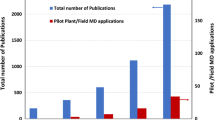Abstract
The paper presents the characteristics of a laboratory-made water-selective composite membrane with a selective layer of hydrophobic polyvinyltrimethylsilane (PVTMS) for use in the processes of vapor-phase membrane recovery of alcohols from dilute aqueous alcohol mixtures of biogenic origin. The support is a polyacrylonitrile ultrafiltration membrane, and the PVTMS skin layer of the resulting composite membrane has a thickness of 3 to 4 microns. The vapor transport and separation characteristics of the membrane for water–ethanol and water–butanol mixtures in the temperature range of 60–80°C have been studied. It has been shown that the membrane selectivity varies in the range of 23–39 for the water/ethanol pair or 100–140 for the water/butanol pair. A specific feature of the hydrophobic water-selective membrane as applied to the vapor-phase process is the stability of its characteristics due to the absence of swelling, in contrast to hydrophilic water-selective membranes whose characteristics substantially depend on the activity of water vapor. The process of vapor-phase membrane recovery of ethanol and butanol from dilute aqueous alcohol mixtures of biogenic origin with their initial concentrations of 10 and 1 wt %, respectively, has been mathematically modeled on the basis of the experimental data. The calculation results show that the composite membrane obtained makes it possible to concentrate ethanol and butanol to 95 and 98 wt % with degrees of recovery of more than 0.8 and more than 0.9, respectively.









Similar content being viewed by others
REFERENCES
I. I. Moiseev and N. A. Plate, Chem. J., No. 6, 45 (2006).
S. Varfolomeev, Chem. J., No. 8, 36 (2009).
P. Stepanenko, Chem. J., No. 9, 30 (2008).
V. V. Volkov, A. G. Fadeev, V. S. Khotimskii, et al., Ross. Khim. Zh, No. 6, 71 (2003).
N. Qureshi, et al., Biotechnol. Prog. 22, 673 (2006).
A. Oudshoorn, A. M. Luuk, L. Wielen, and A. Straathof, Ind. Eng. Chem. Res. 48, 7325 (2009).
N. Qureshi and H. P. Blashek, Renew. Energy 22, 557 (2001).
L. M. Vane, Chem. Technol. Biotechnol. 80, 603 (2005).
K. D. Jitesh, V. G. Pangarkar, and K. Niranjan, Bioseparation 9, 145 (2000).
A. V. Yakovlev, M. G. Shalygin, S. M. Matson, et al., J. Membr. Sci. 434, 99 (2013).
M. G. Shalygin, A. A. Kozlova, A. I. Netrusov, and V. V. Teplyakov, Pet. Chem. 56, 984 (2016).
A. G. Morachevskii, Thermodynamics of Liquid–Vapor Equilibria (Khimiya, Leningrad, 1989) [in Russian].
E. P. Ageev and V. V. Lunin, Laboratory Works on Physical Chemistry: Thermodynamics, (Akademiya, Moscow, 2010), p. 224 [in Russian].
J. Gmehling and U. Onken, Vapor–Liquid Equilibrium Data Collection, vol. 1 of Dechema Chemistry Data Series (Dechema, Frankfurt-on-Main, 1977), part 1, p. 1.
V. V. Teplyakov and M. G. Shalygin, Pervaporation, Vapour Permeation and Membrane Distillation: Principles and Applications, Ed. by A. Basile, A. Figioli, and M. Khayet (Elsevier, Amsterdam, 2015), p. 177.
A. A. Kozlova, M. G. Shalygin, and V. V. Teplyakov, Int. J. Membr. Sci. Technol. 3, 56 (2016).
A. G. Fadeev, et al., J. Membr. Sci. 186, 205 (2001).
www.sulzer.com//media/files/products/separationtechnology/evaporation/process_technology.ashx. Accessed March 5, 2018.
I. B. Elkina, A. B. Gilman, V. V. Ugrozov, and V. V. Volkov, Ind. Eng. Chem. Res. 52, 8856 (2013).
Yu. P. Yampolskii and V. V. Volkov, J. Membr. Sci. 64, 191 (1991).
http://vle-calc.com/phase_diagram.html. Accessed March 19, 2018.
A. Yushkin, A. Grekhov, S. Matson, et al., React. Funct. Polym. 86, 269 (2015).
ACKNOWLEDGMENTS
The authors are grateful to N.V. Sadovskaya, the leading research associate at the Center for Collective Use, Branch of Karpov Institute of Physical Chemistry, for assistance in carrying out scanning electron microscopy of composite membranes.
The development of composite membranes with a selective PVTMS layer, the investigation of their vapor-separating properties, the designing of the unique hybrid device for measuring the vapor permeability of membranes, and the modeling of bioalcohol recovery processes were supported by the Russian Science Foundation, project no. 16-14-00098. The development of the procedure and the laboratory facility for the fabrication of various composite membranes was supported by the Federal Agency of Science Institutions of Russia within the framework of the State task to the Topchiev Institute of Petrochemical Synthesis.
Author information
Authors and Affiliations
Corresponding author
Additional information
Translated by S. Zatonsky
Rights and permissions
About this article
Cite this article
Teplyakov, V.V., Shalygin, M.G., Kozlova, A.A. et al. Composite Membranes with a Polyvinyltrimethylsilane Skin Layer for Separation of Water–Alcohol Mixtures. Pet. Chem. 58, 949–957 (2018). https://doi.org/10.1134/S0965544118110075
Received:
Published:
Issue Date:
DOI: https://doi.org/10.1134/S0965544118110075




